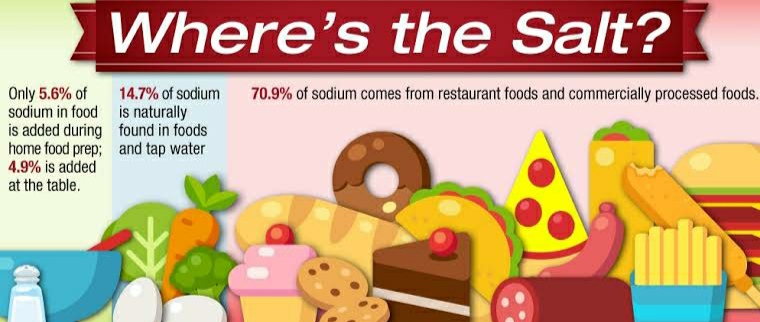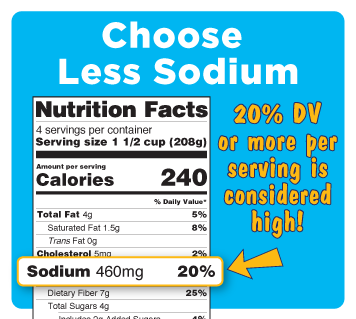6 November, 2020
Just a pinch of salt is what you need !

Common salt (sodium chloride) is the primary source of sodium in our diet. Sodium constitutes 40% by weight of common salt (NaCl). Protein – foods generally contain more naturally existing sodium than vegetables and grains, whereas fruits contain little or none. The addition of table salt, flavored salts, flavor enhancers, and preservatives during food processing accounts for the increased sodium content of most convenience and fast food products. Dining establishment offer large portion thus are increasing the sodium intake even more.
We do not know the minimum requirements of sodium, but studies have it to be 0.2 g per day. And the estimated adequate intake ranges from 1.2 g to 1.5g per day, depending on the age, with lower amounts recommended for the elderly. The table below mentions the estimated adequate intake.
| Age | Estimated adequate intake of sodium (AIs) | Equivalent salt |
| Adult (18-50) | 1.5 g | 3.8 g |
| Adult (51-70) | 1.3 g | 2.0 g |
| Adult (71 and above) | 1.2 g | 1.8 g |
| Tolerable upper intake levels | 2.3 g | 5.8 g (I teaspoon) |
An average Indian consumes 10 to 12 g of salt per day. It is 119% more than the recommended limits of 5-6 g by the WHO. The same is the case with western society.
Healthy kidneys are usually able to excrete excess sodium intake. However, there is concern about persistent excessive sodium intake, which has been implicated in the development of hypertension. In addition to its role in hypertension, excessive salt intake is associated with increased urinary calcium excretion and some cases of osteoporosis. Clinical trials have shown that consuming diets of 1.5 g /day of sodium had better blood pressure benefits than those with higher intakes. Lower sodium diets were shown to maintain low blood over time and enhance the efficiency of certain blood pressure-lowering medications. So sodium intakes have to be limited to not more than 2.3 g/day (equivalent to 6 g of salt) for those with normal blood pressure. For those with higher than optimal blood pressure, the sodium intake has to be limited to 1.5 g per day (equivalent to 2.7 g of salt).
Where does the salt come from?
There is approximately 3g of salt per day naturally in foods we eat, 3g is added during processing, and 4g is added by the individual. Increased reliance on the restaurant, fast food, and commercially prepared convenience food has contributed to this high per capita salt and thus, sodium intake.

Ways to reduce salt intake
Prepare fresh food at home.
Limit the use of packaged foods like sauces, mixes, instant noodles, pasta, and ready- to -eat foods, breakfast cereals, etc.
Avoid the following
Fast food items such as pizza, burgers, etc.
Smoked or cured meats such as bacon, bologna, cold cuts, other processed meats, chipped or corned beef, frankfurters, ham, kosher, or kosher-style meats, and canned meat poultry.
Salted and smoked fish such as cod, herring, and sardines.
Seasonings such as chat masala, Worcestershire sauce, soy sauce, pasta sauces, etc.
- Season your vegetables and meat with lime, vinegar, mint, ginger, parsley as it will reduce the need for salt.
- Limit the intake of cheese (processed) in our diet. Use unsalted-cottage cheese as an alternative. We can flavor the cottage cheese with minced onion, chopped chives, raw green pepper, grated carrots, chopped parsley, or crushed pineapple.
- Choose bake products made from sodium-free baking powder or baking soda. (potassium bicarbonate instead )
- Monitor the sodium content of various medications, including over-the-counter brands.
- Olives in brine and salted nuts also add to your salt consumption.
How to read the food label for sodium content?

Look out for the salt content in every-day food you buy, and choose the lower salt option. Nutrition labels present on the backside of the package make it easier. Flavor enhancers like monosodium glutamate and preservatives like sodium benzoate and sodium nitrate are compounds of sodium and add to your sodium intake.
The food labels might show the salt content as a percentage of your reference intake or have color-coded nutrition information. [Green (low), amber (medium), red (high)].
Some food labels may only state the sodium content. Multiply it by 2.5 to get the amount of salt. ( healthy adult needs no more than 6 g of salt a day).
The underlining message
Reducing the amount of salt is just a matter of habit. Your taste buds will get used to less salty food in 2-3 weeks. A reduction in salt intake will only benefit you. You can be successful if you are motivated to make a significant change in your choice of food and your habit of eating.
Amatullah Merchant
Clinical Nutritionist and Dietitian
Email: amatullamerchant@gmail.com

15 thoughts
Really informative blog. Much thanks again. Want more. Grazia Bradley Wachtel
Do you sell some products with sea salt? kind share more information.
Thanks for writing such a detailed article. It’s incredible how less i care about the daily salt intake and it easily overshoots the daily healthy intake amount of 6g! I ll keep a watch on it! Keep writing

thank you for reading . if I can make a positive difference in your health, my aim of writing will be accomplished. reduce outside and processed foods or ready food in packets, it will reduce the sodium intake. if u need any assistance feel free to contact me.
Thank you for the knowledgeable info
thank you, my pleasure.
Thanx Amatullah for sharing such a important info which we tend to neglect on daily basis..Time to take care of our health in such pandemic crisis.
yes ben, take baby steps ….
Very useful content.
Thank you ben, it is my pleasure
Thank u for the information. Max 6gm / day.
yes, we need to aim at 6 g per day.
Very good Thanks for the healthy knowledge .vll keep in mind .As I have a very high blood pressure ..plz advise for more care n precaution….
Thanks for good health suggestion
thank you , i can surely help u ,but need to know more precisely about your health. You can contact me .